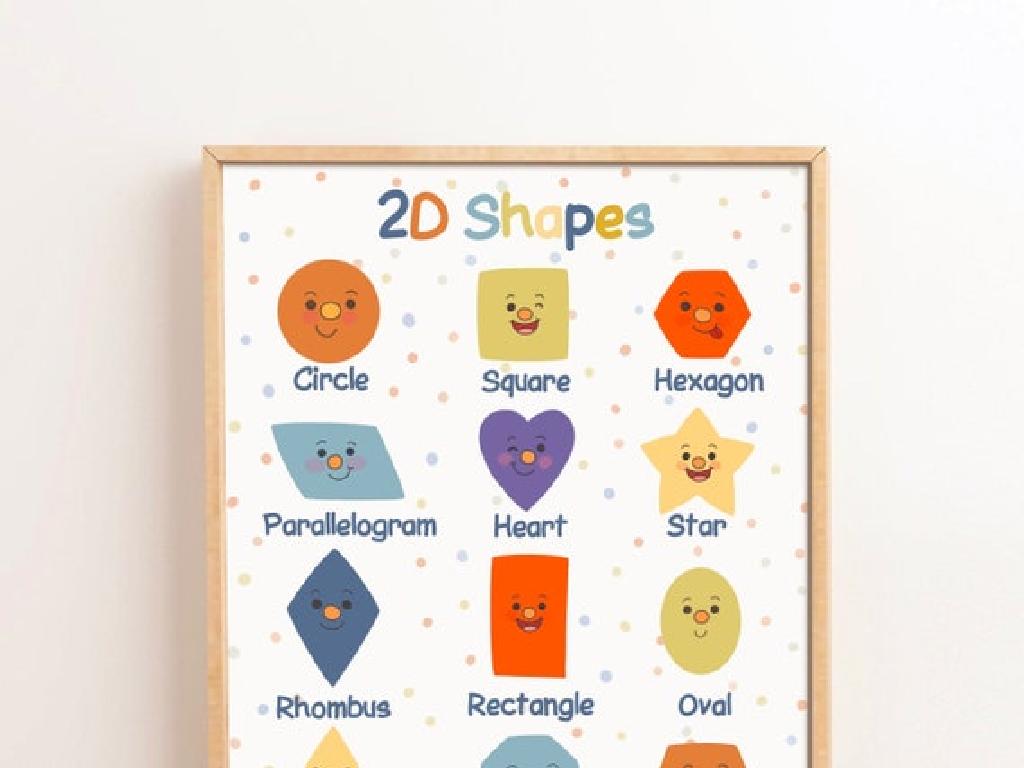Add Two-Digit Numbers Vertically - Sums To 200
Subject: Math
Grade: Second grade
Topic: Addition: Two Digits
Please LOG IN to download the presentation. Access is available to registered users only.
View More Content
Welcome to Addition!
– Becoming addition experts today
– Learn to add two-digit numbers
– Numbers like 34 + 45, where each digit is added separately
– Adding numbers up to 200
– We’ll stack numbers and add ones first, then tens
– Practice with fun examples
– Use examples like 123 + 77 to show carrying over
|
This slide introduces the concept of addition with two-digit numbers, aiming to build a strong foundation for second-grade students. Start by engaging their excitement about becoming ‘addition experts.’ Explain that they will learn to add two-digit numbers, both with and without carrying over. Emphasize that the sum of the numbers they will be adding will not exceed 200. Use visual aids like number blocks or counters to demonstrate the addition process. Provide clear examples, and encourage students to participate by solving problems on the board or with manipulatives. Prepare a set of practice problems for different skill levels to cater to all students.
Understanding Addition
– Addition combines numbers
– It’s like putting 2 baskets of apples together to find the total apples.
– Like adding groups of toys
– If you have 5 toy cars and get 3 more, how many do you have now?
– Use the plus sign (+) for addition
– Practice with sums up to 200
– Let’s try adding 123 + 77. What’s the total?
|
This slide introduces the basic concept of addition to second-grade students. Start by explaining that addition is the process of combining two or more numbers to find a total. Use tangible examples like combining toys to make the concept relatable. Show the plus sign (+) and explain that it’s the symbol we use when we want to add numbers together. Encourage the students to think of addition as gathering all items into one group to count them. To apply this concept, have students practice adding numbers together with sums that do not exceed 200, ensuring they understand the vertical addition format. Provide several examples and use visual aids if possible to help them visualize the process.
Adding Two-Digit Numbers Vertically
– Understand tens and ones places
– Numbers have two digits: one in the tens place, one in the ones place
– Line up numbers by place value
– Write numbers in columns so the tens and ones match up
– Start adding from the ones place
– Add the numbers in the ones column first, then the tens
– Practice with sums up to 200
|
This slide introduces the concept of adding two-digit numbers with a focus on the place value system. Emphasize the importance of understanding the tens and ones places as a foundation for addition. Demonstrate how to properly align numbers by their place values in a vertical format. Start with the ones place when adding, and carry over any extra tens if necessary. Provide examples and practice problems that result in sums up to 200 to reinforce the concept. Encourage students to work through problems step-by-step and verify their answers.
Adding Two-Digit Numbers: Let’s Try an Example!
– Start with adding ones: 4 + 5
– Ones place value: 4 from 34 and 5 from 55
– Then add the tens: 30 + 50
– Tens place value: 30 (from 34) and 50 (from 55)
– Combine ones and tens totals
– Add the results of ones and tens places together
– Final sum: 80 + 9 = 89
– The sum of 34 and 55 is 89
|
This slide is an activity to help students practice adding two-digit numbers vertically. Start by explaining that we add the same place values separately: ones with ones and tens with tens. Use the example 34 + 55 to demonstrate the process. First, add the ones place (4 + 5), then the tens place (30 + 50), and finally combine the two totals to find the final sum. Encourage students to line up the numbers by place value and to always start adding with the ones place. After explaining, give students a few problems to solve on their own or in pairs to reinforce the concept.
Understanding Carrying Over in Addition
– Adding ones can exceed 9
– When ones add to 10 or more, we carry over
– Carry over to the tens place
– We move the extra to the next column on the left
– Let’s practice with an example
– Example: 27 + 18. Add 7 + 8 = 15. Write 5, carry 1 to tens
|
This slide introduces the concept of carrying over in addition when the sum of the ones place is 10 or more. It’s crucial to explain that carrying over helps us manage numbers larger than 9 in the ones place by moving the extra value to the tens place. Use the example provided to walk through the process step by step, ensuring students understand why and how we carry over. Encourage students to practice with additional examples and provide immediate feedback to solidify their understanding. Prepare to assist students who may struggle with the concept by offering manipulatives or drawing the process out visually.
Practice Time: Adding Two-Digit Numbers
– Try adding 47 + 68
– Line up numbers by place value
– Place ones under ones and tens under tens
– Carry over when numbers add to 10 or more
– If ones add up to 10 or more, carry over to tens
– Check your work carefully
– Make sure your sum makes sense
|
This slide is an activity for students to practice adding two-digit numbers with sums up to 200. Students should first attempt to add 47 and 68 on their own. Remind them to align the numbers vertically by place value, ensuring that ones are under ones and tens are under tens. Emphasize the importance of carrying over to the next column when the sum of the ones place is 10 or more. After completing the addition, students should double-check their work. Provide guidance and be ready to assist any student who may be struggling with the concept of carrying over. Prepare to offer additional examples if needed and praise students for their efforts and correct answers.
Checking Our Addition Work
– Reviewing the practice problem
– Remember to carry over
– When a column adds up to 10 or more, we carry over to the next column
– Calculate 47 + 68
– Add the ones place: 7 + 8 = 15, write 5, carry over 1
– Find the sum together
– Add the tens place: 4 + 6 + 1 (carried over) = 11, write 11
|
This slide is aimed at reinforcing the concept of carrying over when adding two-digit numbers. Start by revisiting the practice problem done by the students. Emphasize the importance of carrying over when the sum of one column is 10 or more. Work through the example problem 47 + 68 step by step, adding the ones place first and then the tens place, including the carried number. Encourage students to check their work by redoing the problem and comparing the sum. This exercise will help solidify their understanding of vertical addition and prepare them for sums up to 200.
Addition Tips and Tricks: Sums to 200
– Start from the right side
– Begin with the ones place, then move left
– Double-check your addition
– Add the numbers twice to confirm the sum
– Practice regularly
– The more you add, the better you get!
– Use these tips for accuracy
|
This slide is aimed at helping second-grade students learn how to add two-digit numbers with sums up to 200. Emphasize the importance of starting from the rightmost digits (the ones place) and moving to the left towards the tens place. Encourage students to always verify their answers by adding the numbers again, which helps catch any mistakes. Stress the value of regular practice to improve their addition skills. These tips are not just for the current lesson but are good habits for all future math work. During class, provide various examples and have students practice in pairs or groups to reinforce these concepts.
Class Activity: Addition Race
– Split into teams for a math challenge
– Solve different addition problems
– Add numbers within 200 vertically
– Write answers on the board
– Practice neatness and accuracy
– First team to finish wins!
|
This activity is designed to encourage teamwork and practice addition skills. Divide the class into small groups, ensuring a mix of abilities in each team. Provide each team with a set of addition problems that add up to sums within 200. Each team will work together to solve their set of problems and one member will write the answers on the board. Emphasize the importance of neatness in writing numbers one below the other for clear vertical addition. The first team to correctly complete all their problems wins. Possible variations of the activity could include a relay race where each student solves one problem before passing it on, or a ‘math scavenger hunt’ where each correct answer leads to the next problem. This activity will help reinforce the concept of adding two-digit numbers and the importance of teamwork.
Great Work on Addition!
– Proud of your addition skills
– Keep practicing with worksheets
– Use the worksheets to become faster at adding
– Next lesson: Subtracting numbers
– We’ll learn to take one number away from another
– Math is fun and you’re doing great!
|
This slide is meant to congratulate the students on their progress with adding two-digit numbers and to encourage them to continue practicing at home. The worksheets provided should be used to reinforce their skills and prepare them for the upcoming lesson on subtraction. It’s important to remind them that practice is key to becoming proficient in math. For the next class, prepare materials that will introduce the concept of subtraction in a fun and engaging way, ensuring that the transition from addition to subtraction is smooth for the students.






